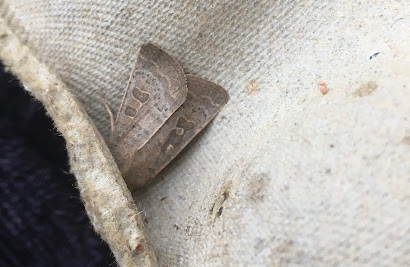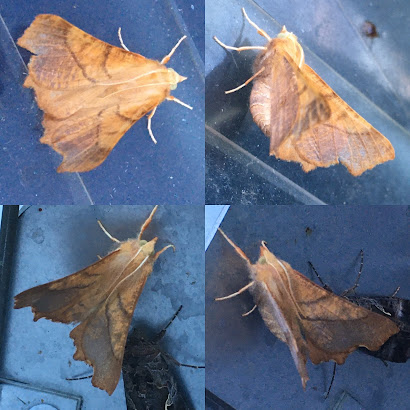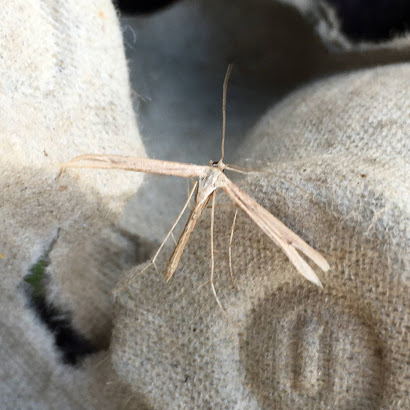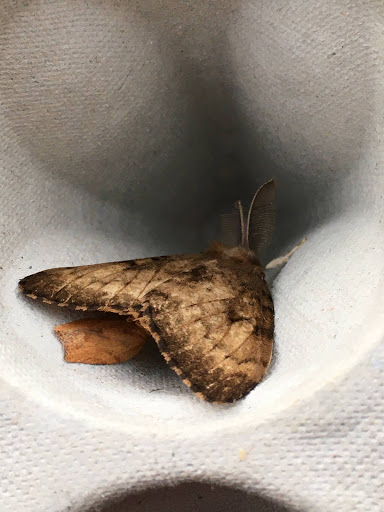The arrival of that very attractive moth the Frosted Orange usually gives me an early sense of Autumn approaching. Indeed moth students often reckon that this time of the year sees a bit of a lull between the tail of the 'Summer moths' and the arrival of the 'Autumn' ones. Be that as it may, there are still plenty of interesting arrivals in the trap, of which the Frosted Orange is a specially welcome example.
Saturday 29 August 2020
Autumn outriders
Friday 28 August 2020
Five year plan
It's five years since the Pale Eggar paid me a visit, and that was a first. A discriminating moth then and one whose distinctive appearance is nurtured, often, by two years spent in its pupa transforming from caterpillar to adult. I am fond of the family as we bred caterpillars of the bigger and more colourful Oak Eggar at school and I have seen males of their relative the Fox moth flying by day in the Lake District and found its caterpillars on the heather there.
My next visitor is more the size of the big eggars or even larger, and also an Old Faithful in the moth trap at this time of year. And elsewhere. Penny spotted one on a grey and red pub sunshade on a visit to Radcot on the Thames before we moved South and we've seen them day-flying on other occasions since. A grand experience!
It's the Red Underwing, one of the many moths which keeps its glorious underwear out of sight unless agitated or preparing for take-off. However, you can get a quiet glimpse of what is in store by manoeuvring the moth so that you can photo its underwings, as in my first two pictures of it above. and below.
This one has clearly been about a bit but was still a very strong flyer. After I had tickled it into showing a little red from above, it took off at a great rate and soared away. Within seconds it was at treetop level and out of sight.
Monday 24 August 2020
Yoesden's wonderful Blues
It's perhaps a bit early to talk about an annual treat when this year was only my second time, but Penny and I had a wonderful pilgrimage to the Adonis Blues of Yoesden Bank nature reserve yesterday. When I reported my inaugural day out there last August, I called the little jewel of a butterfly perhaps the most beautiful in the UK. I hold to that; and visiting it is a much more enjoyable experience than hanging around in Bernwood Forest waiting for Purple Emperors to deign to come down from their treetop home.
 The reserve is a steep hillside opposite the village of Radnage and only a short walk from the peaceful oasis of the local church. On a sunny day at this time of year, you encounter the Adonis Blues almost as soon as you come through the gate at the top of the hill on the foopath down from Bledlow Ridge. They like the short turf studded with the rare (but not here) Chiltern Gentian, pictured left. As the bank descends, the grass gets longer and thicker, with Cornflowers and Scabious in rich clumps. There are still plenty of butterflies but few if any Adonises.
The reserve is a steep hillside opposite the village of Radnage and only a short walk from the peaceful oasis of the local church. On a sunny day at this time of year, you encounter the Adonis Blues almost as soon as you come through the gate at the top of the hill on the foopath down from Bledlow Ridge. They like the short turf studded with the rare (but not here) Chiltern Gentian, pictured left. As the bank descends, the grass gets longer and thicker, with Cornflowers and Scabious in rich clumps. There are still plenty of butterflies but few if any Adonises.
Sunshine was rare yesterday but luckily accompanied our first 20 minutes in the reserve when I took the pictures above. The clouds then closed in until late afternoon, when we were well away on a circular walk after pork pie, hard-boiled eggs and other delights in the churchyard.
The effect of the change of the weather was fascinating to see, however, because the blues simply shut up shop and closed their wings. They were still easy to find on flowerheads and we spent ages watching two of them and willing them to give us another glimpse of that exquisite blue. They just wouldn't. So in the end, we put the iPhone on video and tickled the butterflies with grass, to record them flitting briefly away. Here's a composite film of three of them - with titles too, an exciting first for Martin's Moths:
I've also made a composite of snatch shots from the film which, though blurred, perhaps give an idea of the wonderful experience of seeing these butterflies. Yoesden is the most northerly point of their UK range but perhaps this will gradually increase in the years to come.
The bank is also the home of Chalkhill Blues, another very pretty chalkland butterfly, and Small Blues, though we didn't see any of those. Here are a couple of Chalkhills, a male (topwing and underwing) and a female. As so often with moths, the missus gets the poorer deal.
And to round things off, here are a couple of Yoesden grasshoppers, of whiuch there were scores leaping about.
Sunday 23 August 2020
Nearly missed - another newcomer
I particularly noticed his comment because Penny was chief sub-editor of Cosmopolitan magazine when we were courting - a fact which did wonders for my street cred. (She modestly responds that the fact that I worked for The Guardian at the time did the same for her. If so, I was borrowing from the lustre of others). Anyway, more important from the moth point of view, Dave's discovery put me on the qui vive.
 |
I have had my share of rarities, including the matchless Clifden Nonpareil, but I never expect them. But then the Upper Thames Moths blog showed its matchless value again. Checking back, I re-read a post from Dave on 19 August, in which he showed a Webb's Wainscot in his trap and noted that it had become an annual visitor for some years. I posted my pics on the UTM blog and bingo! I have a new species for my garden list. I'd kept it briefly in a box while waiting for a response on UTM and I took the next two photos of it in captivity. Isn't it interesting how iPhones' digital lenses respond to different light? The photos above are much more the colour of the moth to my eyes, than those below.
Perched nearby on the cowl was one of my top favourites, the Chinese Character, known to my grandchildren (and many others) as the Bird Poo Moth. Here it is, along with two other regular visitors which always delight me with their green, in the case of the Light Emerald, and their yellow, for the Brimstone:
A second Light Emerald caught my eye in plants near to the trap. And look, in the second picture, who it's got for company:
Saturday 22 August 2020
Taking advent-age
Although the moths continue abundant, I thought on first inspection on Friday morning that there was nothing of interest in the trap. Then, while packing back the eggboxes to protect the sleepers from hungry birds, I spotted this little chip; and he or she does have a story to tell.
Meet Blastobasis adustella, a typically sonorous Linnaean name but better, for once, than its English counterparts are Furness Dowd or Dingy Dowd. The latter is taking it a bit far as although the poor thing's colours are indeed dowdy, the chevron mark does give it some distinction.
I couldn't resist Googling 'dowd' by the way and found it to mean 'a person of dull and unfashionable appearance', a seldom-used noun from a commonly-used adjective, even though its first written use was in mediaeval times.
Its interest is as an 'adventitious species' - hence my groanworthy pun in my heading. These are defined as creatures, not necessarily moths or even insects, which take advantage of something outside the natural world to spread their range. In the case of adustella, the something was the horticultural trade. The first arrivals of the moth in the UK almost certainly came, un-noticed, with consignments of plants from overseas for garden centres.
You can be forgiven for not noticing them. They are tiny-weeny, just a few millimetres long though the full wingspan can reach 19mm. They were first recorded in the UK in 1984 and may have come from Madeira which is a stronghold of the Blastobasis family. Adustella has loads of relatives and a really careful moth recorder would attempt to carry out difficult checks in case their find was the very similar B. maroccanella which has also begun to make a home here. I am afraid that does not include me.
More conventional arrivals included the visitors below: a couple of Common Waves with their slightly orangey, delicate bars (Update: Thanks once again to Edward - the first is a Common White Wave, sorry) and a Common Plume with a little gap in its wings which are usually as tightly-furled as an old-fashioned City gent's umbrella.
Wednesday 19 August 2020
When the light comes on again
After a week of inactivity, the moth trap was back in action last night at last. And, goodness, were the eggboxes busy. I had a feeling that they would be, as the evening was lovely and warm when I lit the lamp after my Zoom yoga on the lawn. (I wonder if this attracts the moths, if only out of curiosity. During the periods when I was lying on my back, a pose I enjoy, I saw first a couple of hawking dragonflies and at the end, as dusk drew on, plenty of bats).
I took these photos of the light too, immediately after switching it on, not realising at the time that one showed a dark sky while the other, taken a couple of seconds later if that, has a shining light. Spooky. Or maybe a 'plane.
Most of the 350 or more arrivals were standard guests: large numbers of the various Yellow Underwings; lots of faded Green Carpets, full many a Burnished Brass. But there were two who were both new to my records and also interesting: Gypsy moths, which strike terror into the hearts of tree owners because of the devastation which can be wrought by their caterpillars when they congregate en masse.
I don't need telling about caterpillars during my current war to the death with 'Cabbage White' ones, so I've dutifully reported my guests to Forest Alert. This needs doing, I think, because the Gypsy moth is on a real roll. It was reckoned extinct in the UK by 1909 when the last endemic colony in the fenlands of East Anglia disappeared. But now the moth is making tremendous headway from continental Europe. I first saw one in my grandchildren's garden (or strictly, on their dining room windowsill) exactly a year ago and recently two other members of the Upper Thames Moths blog have recorded them in their traps.
Although a potential pest, the moths are very attractive and famous for their front view pose, with those beady eyes and great big, bushy antennae. It had to head this post. I thought that I had the just the one moth but then a final eggbox revealed another, tucking itself snugly into one of the cones and sheltering a little tortrix micro moth in the process:

















































